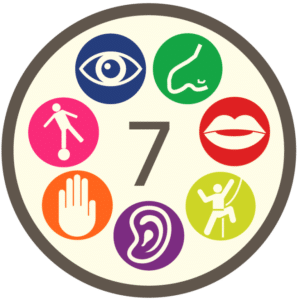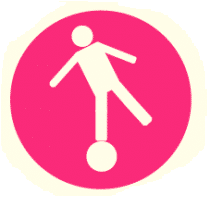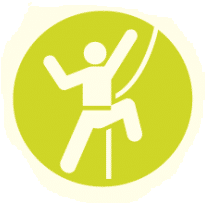Max discusses the 7 senses
Buy Now: The Ultimate Digital Sensory Journal by Comfa
In our everyday lives, we rely heavily on our senses to navigate, learn, and experience the world around us. But from an early age we are told that we have five senses: vision, hearing, taste, smell, and touch. However when it comes to looking at the ways that the body receives information in relation to sensory input, it now is widely accepted that there are at least 7, with the additional ones being vestibular, and proprioception( some people make the argument that Interoception is an eighth sense, that of the internal body, but for the purposes of this article we will be looking at the outward ones only.)

The 7 Senses
Each sense plays a unique role in how we perceive and interact with our environment. For instance, vision allows us to see and interpret the visual world, while hearing enables us to process sounds. Taste and smell work closely together in experiencing flavors and scents, and touch provides us with critical information about textures and temperatures. The vestibular sense, located in the inner ear, is key for balance and spatial orientation, whereas proprioception involves our sense of body awareness and movement.
Related- What is Sensory Processing Disorder?: Symptoms, Causes, and Treatments
Sensory balance is essential for effective functioning and well-being. When our senses are in harmony, we can navigate our environment efficiently and comfortably. However, for individuals, especially children, with sensory processing challenges, such as those who have ADHD, achieving this balance can be a struggle. Sensory processing disorder (SPD) can lead to either overstimulation or understimulation in one or more senses, affecting daily life and learning. Understanding sensory balance is crucial for supporting those with SPD and similar challenges. The vestibular system is particularly integral to maintaining this balance.

Vision is the first sense a lot of people think of, allowing us to perceive up to 80% of all information. It’s not just about seeing but interpreting and understanding the visual world around us, and giving our brain the correct information with which to make decisions about safety, navigation or social interactions. Overstimulation in vision can lead to issues like light sensitivity or difficulty processing visual information. Understimulation, on the other hand, might manifest as a lack of interest in visual tasks or poor visual tracking.
Related: Visual Stimulation: Top 10 techniques to help over (or under) sensory stimulation

Hearing enables us to process and make sense of the sounds around us. It supplements vision to create a more in depth picture of the whole surroundings, even for things that we may not be aware of such as people behind us. Neurotypical brains are very good at filtering out alot of the small, inconsequential noises of every day life, such as a clock ticking, or someone breathing. However those with challenges in this sense can experience either hypersensitivity to sounds, feeling like the ticking clock is a hammer in their brain, or a need for louder and all encompassing sounds.

The sense of taste allows us to enjoy and discern flavors. It has evolved over millions of years to act as both a generator of pleasure from pleasant tastes, as well as a safety mechanism to detect potentially dangerous or unpleasant foods.Overstimulation in taste could result in someone appearing as being overly picky with foods, preferring to stick to bland or repetitive foods, while understimulation might lead to eating non-food items (pica) or craving intensely flavored foods.

Smell is closely linked to taste and plays a crucial role in how we experience food and our environment. It is also a further safety mechanism to alert the brain to potential dangerous situations where smells are involved, such as a gas leak. Overstimulation of the smell sense can manifest as sensitivity to odors, such as strong perfumes or the smell of a bin, while understimulation might mean a decreased sense of smell, not noticing smells that might make others gag or enjoy.

Touch is vital for human connection and understanding our physical world. Without the sense of touch we would be unable to navigate our surroundings, as well as interpret objects around us. Overstimulation can lead to discomfort with physical contact, while understimulation might result in a constant need to touch things or people.

The vestibular sense helps with balance and spatial orientation. Created by the vestibule of the inner ear, it is this sense that is affected by things like riding a merry-go-round. It tells us which way is up and down without having to think about it. Challenges here can result in difficulties with coordination and movement, such as feeling unable to place which direction they are facing in a dark room, or losing balance easily.

Proprioception involves knowing where our body parts are in relation to each other. It is the sense that allows us to move our legs without looking at them all the time. It’s crucial for motor skills and coordination. Issues can manifest as clumsiness or a lack of awareness of body position.

When it comes to managing overstimulation, individualized approaches are key. For vision, reducing exposure to bright lights or using colour therapy might help. For auditory challenges, noise-cancelling headphones can make a big difference in how much sound reaches the ears. Taste sensitivity can be managed by introducing new flavours gradually, while for smell, avoiding strong odours is beneficial. For tactile overstimulation, using clothing with comfortable textures, like the Fidget-T, can provide relief. Vestibular overstimulation might be managed through exercises that improve balance, and proprioceptive challenges can be addressed with activities that enhance body awareness such as pushing against a wall.

As with overstimulation, to address understimulation engaging the senses in a balanced way is crucial. For vision, activities like puzzles or visual arts can stimulate interest. Auditory understimulation may benefit from music therapy or sound-based games. Introducing a variety of foods can awaken the sense of taste, while exploring different scents can help with smell. Engaging in various textures and touch experiences can address tactile understimulation. Exercises that challenge balance can stimulate the vestibular system, and activities like yoga or dance can improve proprioception.
It’s important to remember that sensory needs are highly individual, and what works for one person may not work for another. This is particularly true for individuals with additional neurodivergences. Additionally, it is common for the way that each sense is received to change regularly. Someone may be overstimulated visually one day and understimulated the next. The uniqueness of sensory experiences and needs is particularly relevant when considering the vestibular and proprioceptive systems, with a key element of any attempt to build a sensory diet for these senses being the need to tailor sensory experiences to each individual’s unique requirements.
The 7 senses are vision, hearing, taste, smell, touch, vestibular (balance), and proprioception (body awareness).
Overstimulation can vary: bright lights may overwhelm vision, loud noises can affect hearing, strong flavours might upset taste, powerful odours can impact smell, rough textures could disturb touch, excessive movement might disorient the vestibular sense, and spatial disorientation can affect proprioception.
Techniques vary per sense: dimming lights for vision, using noise-cancelling headphones for hearing, gradually introducing new flavours for taste, avoiding strong odours for smell, wearing comfortable textures for touch, balance exercises for vestibular challenges, and activities that enhance body awareness for proprioception.
Understimulation of the senses can manifest in various ways: Dim lighting may lead to visual strain, soft sounds can hinder auditory processing, bland flavours might dull taste experiences, faint odours could impair the sense of smell, overly smooth textures may reduce tactile engagement, minimal movement might affect vestibular development, and a lack of spatial challenges can weaken proprioceptive awareness.
Understimulation also varies: puzzles or visual arts for vision, music therapy or sound games for hearing, introducing diverse foods for taste, exploring different scents for smell, engaging with various textures for touch, balance-challenging exercises for vestibular, and yoga or dance for proprioception.
Sensory needs are highly individual, especially for people with additional neurodivergences. Tailoring sensory experiences to each person’s unique requirements is crucial for effective management and comfort.
Swatches are only available to order from the United Kingdom.